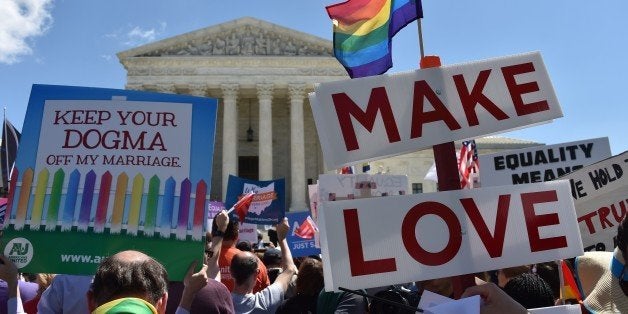
Marriage has never been the ultimate goal of the LGBT movement. Instead, marriage has only ever been a means of achieving the movement's true end goal -- full acceptance in American society. Yet, heady with the recent quick progress in extending the right to marry nationwide, it sometimes seems as if marriage has become the movement's end rather than just another step toward a larger goal.
But with increasing pushback from conservatives around the country (no, it's not just an Indiana problem or protesters making a scene at the Supreme Court), the LGBT community is reminded that we still have a long way to go before achieving full acceptance in American society. Notwithstanding the tea-leaf reading that will likely become a national obsession in the coming weeks, the real mystery is not how the Supreme Court will rule in the marriage cases that it heard yesterday, but just how much of a backlash the LGBT community will experience in coming years from the torrent of decisions in its favor since the Supreme Court's 2013 decision in United States v. Windsor.
About a year before the Windsor decision, Justice Ruth Bader Ginsburg remarked that the Supreme Court's decision in Roe v. Wade had triggered a decades-long backlash because it moved the country "too far, too fast" on the question of abortion. In the months leading up to the Windsor decision, there was much debate about whether this fear of moving "too far, too fast" should influence the Supreme Court as it considered the legal status of same-sex marriage at the state and federal levels. In response to this debate, a New York Times editorial correctly asserted that we should not deny some people's basic rights out of fear of an angry reaction from others.
But how a question ought to be answered once posed is different from strategizing about when and how to pose the question in the first place. This naturally should move us to ask whether the LGBT movement has pushed the several states to recognize marriage too quickly, creating hollow victories and placing obstacles in its own path to achieving the ultimate goal of full acceptance in American society.
Among the states where same-sex relationships were legally recognized prior to the Windsor decision, there was somewhat of a natural progression toward relationship recognition. These states usually first acknowledged the historic discrimination against the LGBT community and brought members of that community under the umbrella of legal protections against discrimination in housing, employment, and public accommodations. These states also often took steps to legally recognize LGBT families by repealing outdated bans on adoption by lesbians and gay men or by permitting second-parent adoptions so that both spouses in a same-sex couple would be legally recognized as a child's parents. Indeed, these steps were sometimes cited in support of extending the right to marry to same-sex couples.
In the wake of the Windsor decision, however, this progression has reversed itself. Many of the states that have now been compelled by the courts to legally recognize same-sex marriage lack legal protections against discrimination on the basis of sexual orientation. This includes my home state of Pennsylvania. Following the federal court decision extending the right to marry to same-sex couples here last May, people were often surprised when I explained that while it is now legal for same-sex couples to marry in Pennsylvania, there is no statewide law preventing an employer from firing one or both spouses because of their sexual orientation.
In states like Pennsylvania, the possibility of losing a job or housing or being denied service in a restaurant will obviously deter some same-sex couples from taking the step of marrying -- or, if they do marry, from publicly announcing or acknowledging their marriage. So much for being out and proud and advancing our acceptance by society.
In justifying their push for marriage equality in conservative areas of the country, national LGBT organizations cite the national consensus that has developed around legally recognizing same-sex marriage. But, however real that national consensus might be, none of us lives in a national consensus. Many still face the reality of living in states or localities that are hostile to the LGBT community.
While it might have been a better strategy to first push for marriage equality in liberal and liberal-leaning states and then to leverage the building national consensus to put some of the same legal protections in place at the state or federal level before heading to court in more conservative states, it is too late to do that now. That important work will have to come after the battle for marriage equality has concluded -- whether that happens with a Supreme Court decision in June or sometime later. The only real question now is how much harder that work -- and the ultimate goal of full acceptance by society -- will be to accomplish.
